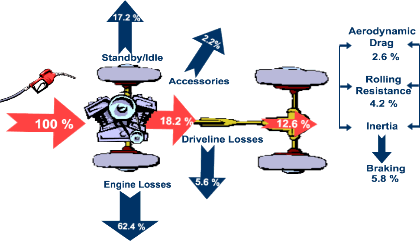|
Vehicle Design
Vehicle
Efficiency
Due to
government regulations, societal influences, and increasing
competition there is an increased effort to improve vehicle fuel
economy and emissions.
Only about 15% of the energy in the fuel you put in your gas tank
gets used to move your car down the road with a typical internal
combustion engine, while the rest of the energy is lost. Because of
this the potential to improve fuel economy with advanced
technologies is enormous.

Paths of
energy through a typical gasoline-powered vehicle in city driving
The 12.6% of
original fuel energy that makes it to the wheels must provide
acceleration (5.8%) and overcome aerodynamic drag (2.6%) and
rolling resistance. In a highway driving environment, aerodynamic
drag, which increases at an increasing rate with speed requires the
most energy (about 10.9%).
The potential for improvements in fuel efficiency as a result of the
design process include reducing vehicle drag,
reducing
vehicle mass, and then improving
powertrain efficiency
with new technologies.
|